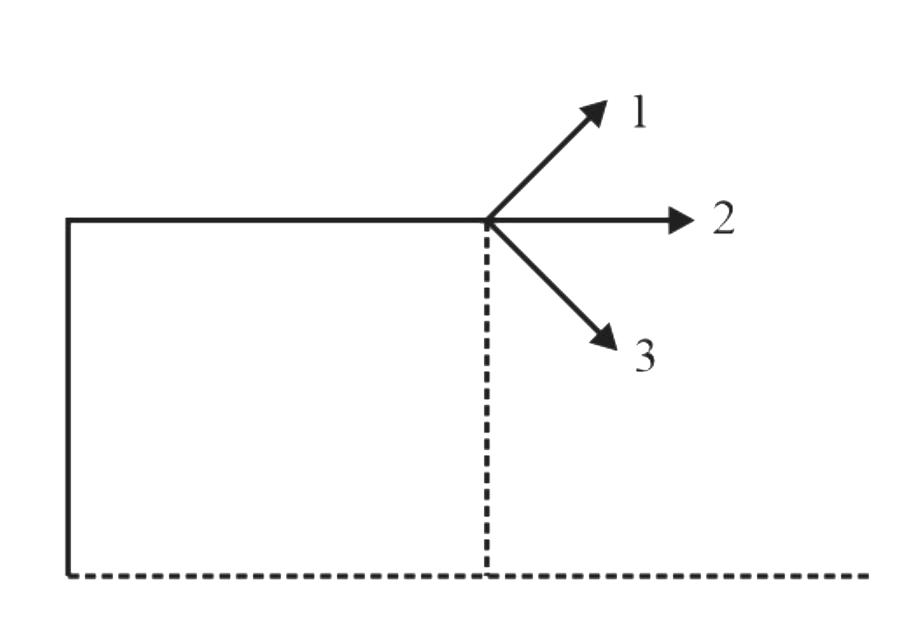Two geometrically identical homogeneous balls are manufactured of different materials. Their densities ball-1 and ball-2 are 800kg/m3 and 200kg/m3 respectively. Both balls are dropped from very high tower. Assume that the air resistance is proportional to the square of velocity. Determine the ratio of the maximum velocities of the ball -1 to ball-2.
2
3
4
6
To solve the problem of determining the ratio of the maximum velocities of two geometrically identical homogeneous balls made of different materials, we can follow these steps:
Step 1: Understand the forces acting on the balls
When a ball is dropped, two main forces act on it:
- The weight of the ball (downward force), given by mg, where m is the mass of the ball and g is the acceleration due to gravity.
- The air resistance (upward force), which is proportional to the square of the velocity, represented as Fv=cv2, where c is a constant and v is the velocity.
Step 2: Establish the condition for terminal velocity
At terminal velocity, the net force acting on the ball is zero. This means that the weight of the ball is equal to the air resistance:
mg=cv2
Step 3: Relate mass and density
Since both balls are geometrically identical, they have the same volume V. The mass m can be expressed in terms of density ρ and volume:
m=ρV
Thus, for ball 1 and ball 2, we can write:
- m1=ρ1V
- m2=ρ2V
Step 4: Substitute mass in the terminal velocity equation
Substituting the expressions for mass into the terminal velocity equation gives:
ρ1Vg=cv21(for ball 1)
ρ2Vg=cv22(for ball 2)
Step 5: Divide the two equations
Dividing the two equations to find the ratio of the terminal velocities:
ρ1Vgρ2Vg=cv21cv22
This simplifies to:
ρ1ρ2=v21v22
Step 6: Take the square root to find the ratio of velocities
Taking the square root of both sides gives us:
v1v2=√ρ1ρ2
Step 7: Substitute the given densities
Given that ρ1=800kg/m3 and ρ2=200kg/m3, we can substitute these values:
v1v2=√800200=√4=2
Final Answer
Thus, the ratio of the maximum velocities of ball 1 to ball 2 is:
v1v2=2
When a ball is dropped, two main forces act on it:
- The weight of the ball (downward force), given by mg, where m is the mass of the ball and g is the acceleration due to gravity.
- The air resistance (upward force), which is proportional to the square of the velocity, represented as Fv=cv2, where c is a constant and v is the velocity.
At terminal velocity, the net force acting on the ball is zero. This means that the weight of the ball is equal to the air resistance:
mg=cv2
Since both balls are geometrically identical, they have the same volume V. The mass m can be expressed in terms of density ρ and volume:
m=ρV
Thus, for ball 1 and ball 2, we can write:
- m1=ρ1V
- m2=ρ2V
Substituting the expressions for mass into the terminal velocity equation gives:
ρ1Vg=cv21(for ball 1)
ρ2Vg=cv22(for ball 2)
Dividing the two equations to find the ratio of the terminal velocities:
ρ1Vgρ2Vg=cv21cv22
This simplifies to:
ρ1ρ2=v21v22
Taking the square root of both sides gives us:
v1v2=√ρ1ρ2
Given that ρ1=800kg/m3 and ρ2=200kg/m3, we can substitute these values:
v1v2=√800200=√4=2
Thus, the ratio of the maximum velocities of ball 1 to ball 2 is:
v1v2=2
Similar Questions
Two balls are dropped from heights h and 2h respectively from the earth surface. The ratio of time of these balls to reach the earth is.
View SolutionA particle (A) is dropped from a height and another particle (B) is thrown in horizontal direction with speed of 5 m/s from the same height. The correct statement is
View SolutionA ball is dropped from height 10 m . Ball is embedded in sand 1 m and stops, then
View SolutionA ball is dropped from the top of a tower of height 78.4 m Another ball is thrown down with a certain velocity 2 sec later. If both the balls reach the ground simultaneously, the velocity of the second ball is
View SolutionA ball is dropped from the top of a building 100 m high. At the same instant another ball is thrown upwards with a velocity of 40ms−1 from the bottom of the building. The two balls will meet after.
View SolutionA ball is dropped from the top of a building 100 m high. At the same instant another ball is thrown upwards with a velocity of 40ms−1 from the bottom of the building. The two balls will meet after.
View SolutionA ball is dropped from a height of 5 m, if it rebound upto height of 1.8 m, then the ratio of velocities of the ball after and before rebound is :
View SolutionA lead ball at 25∘C is dropped from a height of 2 km. It is heated due to air resistance and it is assumed that all of its kinetic energy is used in increasing the temperature of ball. Find the final temperature of the ball.
View SolutionThree balls are dropped from the top of a building with equal speeds but at different angles. Balls strike the ground with velocities v1,v2andv3 respectively, then

View SolutionA ball thrown vertically upwards with an initial velocity of 1.4m/s. The total displcement of the ball is
View Solution

